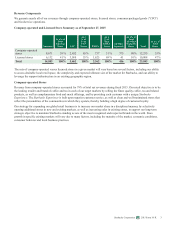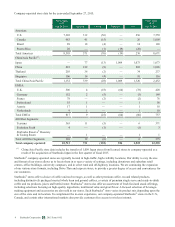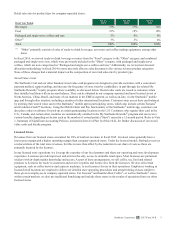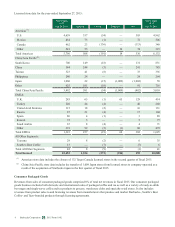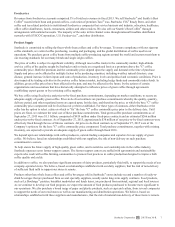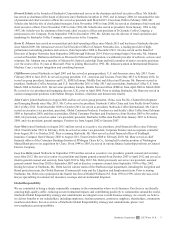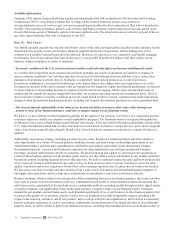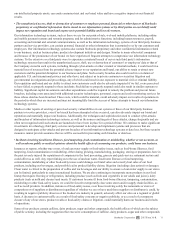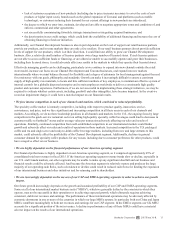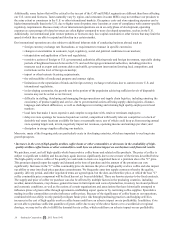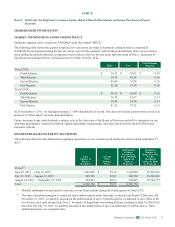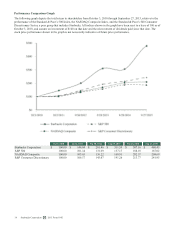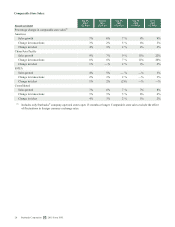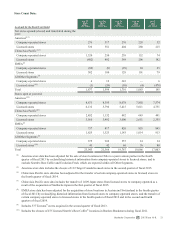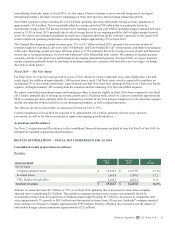Starbucks 2015 Annual Report Download - page 17
Download and view the complete annual report
Please find page 17 of the 2015 Starbucks annual report below. You can navigate through the pages in the report by either clicking on the pages listed below, or by using the keyword search tool below to find specific information within the annual report.
• lack of customer acceptance of new products (including due to price increases necessary to cover the costs of new
products or higher input costs), brands (such as the global expansion of Teavana) and platforms (such as mobile
technology), or customers reducing their demand for our current offerings as new products are introduced;
• the degree to which we enter into, maintain, develop and are able to negotiate appropriate terms and conditions of, and
enforce, commercial and other agreements;
• not successfully consummating favorable strategic transactions or integrating acquired businesses; and
• the deterioration in our credit ratings, which could limit the availability of additional financing and increase the cost of
obtaining financing to fund our initiatives.
Additionally, our Channel Development business is also in part dependent on the level of support our retail business partners
provide our products, and in some markets there are only a few retailers. If our retail business partners do not provide sufficient
levels of support for our products, which is at their discretion, it could limit our ability to grow our Channel Development
business. Also, a relatively small number of licensee partners own a large number of licensed stores. If such licensee partners
are not able to access sufficient funds or financing, or are otherwise unable to successfully operate and grow their businesses,
including their licensed stores, it could adversely affect our results in the markets in which they operate their licensed stores.
Effectively managing growth can be challenging, particularly as we continue to expand into new channels outside the retail
store model, increase our focus on our Channel Development and Teavana businesses, and expand into new markets
internationally where we must balance the need for flexibility and a degree of autonomy for local management against the need
for consistency with our goals, philosophy and standards. Growth can make it increasingly difficult to ensure a consistent
supply of high-quality raw materials, to locate and hire sufficient numbers of key employees, to maintain an effective system of
internal controls for a globally dispersed enterprise and to train employees worldwide to deliver a consistently high quality
product and customer experience. Furthermore, if we are not successful in implementing these strategic initiatives, we may be
required to evaluate whether certain assets, including goodwill and other intangibles, have become impaired. In the event we
record an impairment charge, it could have a material impact on our financial results.
• We face intense competition in each of our channels and markets, which could lead to reduced profitability.
The specialty coffee market is intensely competitive, including with respect to product quality, innovation, service,
convenience, and price, and we face significant and increasing competition in all these areas in each of our channels and
markets. Accordingly, we do not have leadership positions in all channels and markets. In the U.S., the ongoing focus by large
competitors in the quick-service restaurant sector on selling high-quality specialty coffee beverages could lead to decreases in
customer traffic to Starbucks® stores and/or average value per transaction adversely affecting our sales and results of
operations. Similarly, continued competition from well-established competitors in our international markets could hinder
growth and adversely affect our sales and results of operations in those markets. Increased competition in the U.S. packaged
coffee and tea and single-serve and ready-to-drink coffee beverage markets, including from new and large entrants to this
market, could adversely affect the profitability of the Channel Development segment. Additionally, declines in general
consumer demand for specialty coffee products for any reason, including due to consumer preference for other products, could
have a negative effect on our business.
• We are highly dependent on the financial performance of our Americas operating segment.
Our financial performance is highly dependent on our Americas operating segment, as it comprised approximately 69% of
consolidated total net revenues in fiscal 2015. If the Americas operating segment revenue trends slow or decline, especially in
our U.S. and Canada markets, our other segments may be unable to make up any significant shortfall and our business and
financial results could be adversely affected. And because the Americas segment is relatively mature and produces the large
majority of our operating cash flows, such a slowdown or decline could result in reduced cash flows for funding the expansion
of our international business and other initiatives and for returning cash to shareholders.
• We are increasingly dependent on the success of our CAP and EMEA operating segments in order to achieve our growth
targets.
Our future growth increasingly depends on the growth and sustained profitability of our CAP and EMEA operating segments.
Some or all of our international market business units ("MBUs"), which we generally define by the countries in which they
operate, may not be successful in their operations or in achieving expected growth, which ultimately requires achieving
consistent, stable net revenues and earnings. The performance of these international operations may be adversely affected by
economic downturns in one or more of the countries in which our large MBUs operate. In particular, both our China and Japan
MBUs contribute meaningfully to both net revenues and earnings for our CAP segment. In the EMEA segment, our UK MBU
accounts for a significant portion of the net revenues. A decline in performance of any of these MBUs could have a material
adverse impact on the results of our international operations.
Starbucks Corporation 2015 Form 10-K 13


